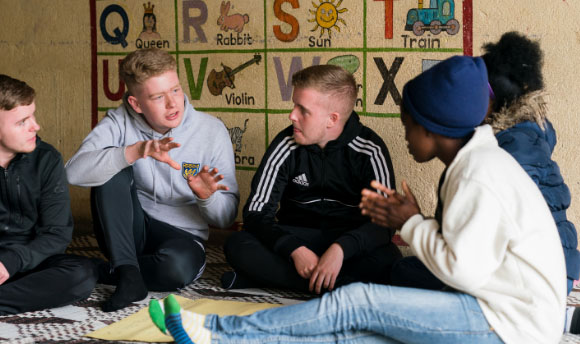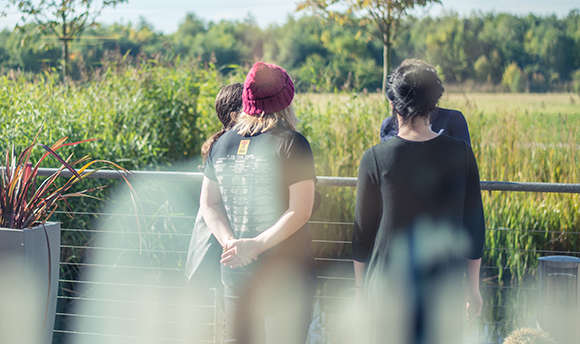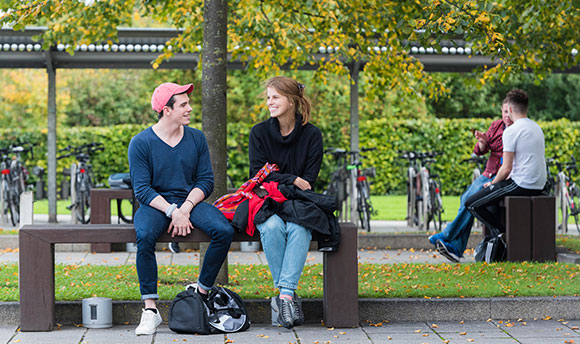This post has been written by a QMU postgraduate British Sign Language/English Interpreting student who is an experienced, professional interpreter and wishes to remain anonymous.
By the Spring of 2020, the global Coronavirus pandemic had entered everyone’s consciousness. Many nations experienced a state of lockdown, and many places of work for interpreters closed their doors. There was a sudden need for interpreters to provide the same, or similar, services from their own homes, coupled with an overall decline in opportunities to work at all.
For me, and other Signed Language Interpreters, this meant taking online courses in remote interpreting, having an on-going dialogue with colleagues and clients to share learnings, investing in additional audio and visual equipment, and finding space at home to create a secure and confidential place to work from. The latter two things may have been the most difficult for many people. Initially, stocks of webcams and headsets quickly ran-out; it wasn’t just interpreters needing to move to being online, it was almost everyone - separated from colleagues, family and friends, with only Zoom and other video-calling platforms to connect us. Finding a space in one’s home to accommodate new equipment, with optimal lighting, soundproofing, and a door to close for privacy, was not easy for many. Interpreters have posted photos of their new workplaces on social media, ranging from their kitchens and dining room tables to their living-rooms, spare and even main bedrooms. These spaces contain make-shift back-drops, second screens, laptops raised to the correct height on piles of books, call-centre headsets and bedroom lamps repurposed as spotlights. Negotiating the need to sequester these spaces in family homes is not easy, nor is it in flat shares, nor is it when living alone or in compact spaces where every square metre has already been claimed. Many of these spaces seem not to be dedicated to this ‘new normal’ way of working. We did not choose the homes we live in, and the rooms therein, anticipating this; many of us chose to live where we could afford, and from where we could travel most easily to our places of work. These new workspaces in our homes are temporary and transient spaces, in competition with what is already there. They co-exist with an urgent, daily need to be returned to how they used to be: as rooms to cook and eat in, to sleep in, and as social spaces. To continue to work as an interpreter in 2020 and beyond, it seems that remote working will prevail. Our living spaces, our places of comfort and safety, are being compromised. Work is here to stay, a houseguest that we can’t ask to leave; we aren’t just working from home, we are living with our work, and it has got its feet firmly under the table.
Many people, in many jobs, are no doubt experiencing something similar. Early on into lockdown, working people were posting their experiences of ‘Zoom fatigue’. Deaf people said, “now do you understand?”, while interpreters said, “this already hard job just got even harder”. Psychologists added explanations. We all said, “yes, that!” in response, relieved to see a rationale for what we were feeling, and why we all wanted to go for a lie-down after finishing another session online.
For interpreters though, there is something else going on. That something has to do with what is now being transmitted into our homes via these various video-remote platforms. The content is in fact much as it has always been for us: doctor-patient consultations, lectures, workshops, work-place meetings, social care assessments, public events etc. What is significantly different is that we have been dislocated from its usual context, and this content now appears on the screens in front of us; its new context being our homes and living spaces.
In our homes, we work alone, despite the presence of others on our screens or in our earpieces. Any previous sense of team, or colleagues, clients, service-users or patients is being redefined by their presence being virtual, and not actual. We are learning about new ways to join, participate in, and leave events. Much of this requires extra effort, and it feels very different to being in the room with them.
In the early weeks of lockdown, Government messages felt ominous, and we braced ourselves for the frightening things taking hold. Seeing familiar faces on-screen provided me with some comfort. In the novel context of interpreting for a lecturer and student group now holding seminars on Zoom, we were “all in it together”, trouble-shooting our way through using the technology. The content was relatively benign, the faces and voices familiar and friendly. None of us had ever visited each other’s homes before, and I doubt we ever will. At the time, it was nice to see these virtual houseguests. Campus had been closed, and we were scattered across the globe, yet we were able to come together and share in forgetting to mute our microphones sometimes or learn what ‘pin video’ means and how useful it can be.
What happens when the content is less benign, when we are again interpreting at home, alone, but dealing with the emotionally and psychologically difficult material that comes our way? There are many events that an interpreter is party to where the upset of others is witnessed and felt, also shared, where the interpreter is affected directly, at the time or subsequently. I have two, recent examples to share of patients and their doctors being in my home, virtually, and my experiences of this.
Firstly, there was the evening when a hospital medical team called the local interpreting agency to request an interpreter for a deaf patient’s emergency surgery. I had already attended both A&E and subsequently the patient’s ward, so I got the agency’s first call to check my immediate availability. After careful consideration, I offered to interpret from home; if the surgery was urgent, remote interpreting provided the doctors with the quickest way of describing the need for it to their patient. Questions could be answered, consent gained, preparations made with the anaesthetists before entering the operating theatre. Alternatively, I could travel to the hospital, as would be usual, but that takes what could be precious time. Within five minutes, the doctors were calling me to give a much-appreciated briefing, and to set-up the video call for the patient. We knew I may still need to travel to the hospital, but we agreed to try it. After twenty minutes, all the necessary had been done. It had all gone without incident, and with success. The technology worked, communication was effective, the patient and I said our farewells with confident smiles, and a “see you later”.
However, there were no guarantees that we would see each other later. All surgery comes with risks. I know this from my own experience, and having interpreted many times for deaf patients pre, peri and post theatre. On this occasion there was a significant risk to the patient’s life. I arranged with the anaesthetist that they could call me again when the patient was in the theatre’s recovery room, and I would either come in or we would try something remotely. I had an estimated four-hour wait, and in that time, at home and alone, I prepared myself for the possibility that the next call would be to tell me that the patient didn’t survive their operation. I thought about how that might feel. I considered what I might need, and what I would do in the middle-of-the-night without the cold but familiar lights of hospital rooms and corridors; also, without the comfort that comes from being in the company of compassionate surgical, medical and nursing staff; they have often welcomed me into their workplace and their ‘family’, making me feel comfortable and ‘at home’, in a place that is nothing like it. Is it an irony that I actually was at home, but it didn’t feel right?
On the second occasion, for a different deaf patient who had already been seen daily, and remotely, from their bed in the red/hot zone of the hospital. They had been steadily improving, but on this day, they were suffering the awful effects of the COVID-19 virus and were in steep decline. The doctor briefed me, before talking to the patient about what could be their last 36 hours. Their major organs were entering shut-down. There was one last medication to try, but chances of it helping were slim.
The patient wanted to see their family. The doctor explained the special arrangements that could be made for this to happen and the exceptional circumstances for granting an otherwise prohibited hospital visit. All of those arrangements, and communication during their visit could be facilitated remotely too, using the iPads that everyone in that part of the hospital were now using to reach those outside of it. None of this is ever easy, for anyone. With COVID-19, families can see their dying loved-ones at the bedside but with the restriction of wearing full PPE. The option was given for remote, on-screen interpreting being available for this visit; the doctor, family and patient may all be in communication and it should not fall on any family member(s) to act as interpreters.
When the interpreter’s work is done in a situation like this, when the call is over, what's next in our domestic video-suites? Wrestle with the pop-up backdrop that won’t pop-down quite so easily, carry-on home-schooling the children, log-on to yet another video platform in readiness for the next webinar? We are witnesses to others’ grief and the cruel tragedy of these awful circumstances, but we not physically present. We are not with them in the way we usually would be. How do we close the wide gap that remote interpreting creates?
Later, the same day, the ward administrator got in touch to pass on the doctor’s thanks and their acknowledgement of the situation having presented many professional and personal challenges. Their care and understanding meant a great deal. The empathy and support conveyed in that phone call was kind-hearted and ultimately humane.
There are advantages to working remotely. To give a few examples: we can communicate with deaf patients without the hindrances of wearing a face mask that obscures our mouths and the facial expressions that are so crucial to effective dialogue. We can also offer our services almost instantly, as illustrated above. We don’t need to join the traffic on our increasingly congested roads or catch the bus/train/tube and increase the potential for exposure to Coronavirus.
As I have described in the two scenarios above, remote working brings new challenges, precisely because we are not in situ. Our authorised absence from our usual places of work means that we may be missing those rapport-building opportunities with both deaf and hearing people, constrained by technology and denied opportunities for direct and private communications all in support of successful interpreted interactions: the walk down the corridor with the doctor, the first few minutes at the deaf patient’s bedside. We may also be denied opportunities to do things for others that are a professional norm and also satisfy a need in us. For example, after the busy ward-round when the doctors have left, staying a little longer and giving time to show compassion to a deaf patient struggling with their condition; asking if there’s anything more we could do to help, is there something they want us to say to their nurse before we go? When a remote interpreting session concludes, we actually ‘go’ nowhere. We are already there, we are home. There is no transition from work to home, in neither time nor space. The usual opportunities to decompress are missing: no café to visit, no walk to the car, no journey to take, no change of air. How, when, and where we process ‘what just happened’ has changed dramatically.
My examples come from hospital settings, but the differences and difficulties of home remote-working extend to many scenarios for many interpreters. We should already know that we work with content, events and people that have potential to upset us. We should all have peer and personal support networks, professional supervision and other self-care mechanisms in-place. These are healthy ‘knowns’, often referenced and emphasised as essential supports to our wellbeing and safe practice; they are (quite rightly) publicly talked of, promoted, and documented in published works. Where we have entered the unknown is in understanding the psychological and emotional effects of home-based, remote working for signed language interpreters. There are no published studies that I can find, specific to this paradigm. Each of us who is now working this way will have started to understand what is and isn’t okay on an individual level. In time, we may be able to identify what is typical for a majority and create specific guidance and self-care materials to support us in this new way of working. It may be useful to consider if there are other home-based workers in similar situations, experiencing similar effects. We could look to home-based therapists in private practice, working with clients who bring ‘their stuff’ to the therapy room. There is a difference though: the therapist will have made a decision to have a room for their work from the outset. This creates a physical boundary that helps to maintain psychic spaces that an interpreter’s existing home may not be able to provide.
I have written this posting as a support to myself. It is one way of processing my experiences and preparing myself for the next time. Writing also helps me to (re)calibrate, to know myself better and reflect on my strengths and vulnerabilities. It is also intended to be a provocation, of the kindest sort, to us all. The words are here for you to take and add to, to challenge and disagree with. It is also a thank you, to the people I work with and for. My gratitude is for the kind doctors, nurses and the patients who have asked me, “are you okay?”. Sometimes it takes very little to make a big difference.
QMU offers a unique master’s level opportunity to achieve a recognised academic qualification with a focus on specialist areas of interpreting practice (for example in healthcare, mental healthcare, legal settings, arts and culture, employment, education and supportive practice). This course is delivered online making it accessible to interpreters throughout the UK.
Other reading, with grateful thanks to their authors and contributors:
- Adams et al 2014. An Interpretative Phenomenological Analysis of Stress and Well-Being in Emergency Medical Dispatchers
-
Jemina Napier, 10 June 2020. The Impact Of The Covid-19 Pandemic On Sign Language Interpreting Working Conditions
-
Maya De Wit. Sign Language Interpreting Consultancy, Coronavirus Pandemic - Info For Interpreters, updated June 2020
-
The Psychological Professions Network, April 2020.
-
WFD-WASLI March 2020. Joint Statement On Access To Health Services







